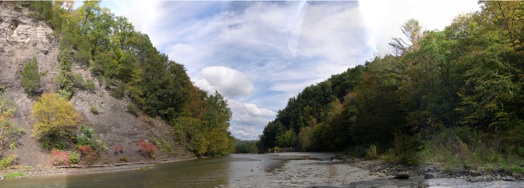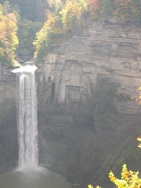Real earth systems Science

What Are Virtual fieldwork Experiences?
What we strive for in developing VFEs:
Fieldwork experiences, whether real or virtual, are ways to engage big ideas in practice.
A field scientist does not have one single possible way to operate in the field. Nor does she have a guide explaining what it is she's seeing at every turn. In the field, she might pick up a rock and take a closer look or pull out a magnifying glass and look at a cliff face.
Just because there isn’t one set way to approach fieldwork doesn’t mean there is no structure to what you do. Sarah Miller created a graphic organizer to help answer the question: Why does this place look the way it does? We’ve updated the organizer and placed it into a VFE Template. The graphic organizer shows some of the ways you should consider as you approach the question and hints at some of the tools you might use.
Field scientists typically would have access to references like maps and field guides (identification keys). Virtual fieldwork should offer some of the same opportunities for exploration as actually being in the field. We hope that there will be the occasional moment of discovery.
If you think that students should be doing real science instead of virtual science, you are right. However, real science can be done at a distance. Astronomy grows at an incredible rate without scientists visiting the places or objects they study. That idea is expanded upon in the description of Mars missions in the Mother of all VFEs.
Virtual Fieldwork Experiences are intended to be an integral part of instruction, not a standalone activity. In some classrooms, they are being used to help prepare for actual trips into the field and to process those excursions afterwards.
It is perfectly reasonable to virtually visit a site several times for further data collection and to study different concepts at the same site. Scientists, of course, do this exactly. In considering virtual fieldwork as recurring practice, it makes sense that the initial experiences are more guided than the later experiences -- there is a gradual transfer of responsibility from teacher to student.
Fieldwork isn’t specific to any one topic within a course. Look at the VFE Graphic Organizer that lays out a set of big questions to investigate and you’ll see questions from across the units of a typical year long course. We hope that fieldwork, whether actual, virtual or a blend of the both actual and virtual, is woven into the fabric of a course.
What a VFE isn't
Virtual Field Trips, or VFTs, have become increasingly common at many levels of education. These experiences tend to be virtual tours rather than opportunities for inquiry. An Internet search will yield many examples of these tours as will a search of the Digital Library of Earth System Education (DLESE). Such resources clearly have value, but they can be seen as an opportunity for teachers to point things out. Learning for understanding involves students figuring things out.
Two very different examples of what we strive for are described in the VFE Vignette and the Mother of All VFEs.
A VFE Vignette
As part of the project, we will be expanding the series of regional Teacher Friendly Guide to Geoscience (The TFG). The Northeast and Southeast Guides are complete and the current grant work will complete the series to cover all of the US. The original guides are quality resources for understanding geology, but in their original form, did not provide guidance about how to help students learn about that geoscience through inquiry approaches. The TFG tells you (the teacher) much about why a place looks the way it does. In revisions of the current guides and in the rest of the series, we are considering including vignettes (like this example) throughout the guide that illustrate teaching through inquiry. The vignette is modeled after those in The National Science Education Standards and describes how a VFE might look in a high school Earth science classroom. The story reflects a classroom familiar with fieldwork experiences.


Check back soon at this page for more links to VFEs and VFE related materials.
NEW August 2011! A Brief Introduction to Creating & Using Virtual Fieldwork
A VFE database UPDATED July 11!
An illustrative vignette about VFEs is here.
Read about the Mother of All VFEs here.
VFE Resources Many new resources added!
